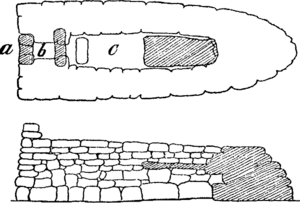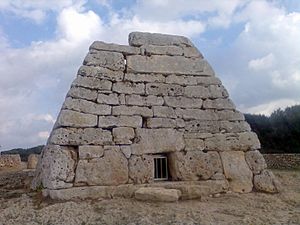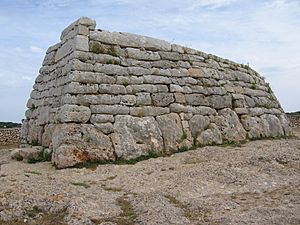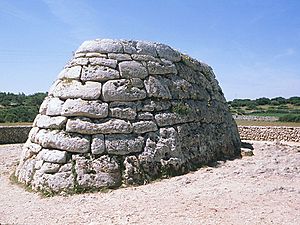Naveta d'Es Tudons facts for kids
|
Naveta d'Es Tudons
|
|

Façade and side wall of the Naveta d'Es Tudons
|
|
| Alternative name | Naveta des Tudons |
|---|---|
| Location | Menorca, Balearic Islands, Spain |
| Coordinates | 40°00′11″N 3°53′30″E / 40.003128°N 3.891558°E |
| Type | Burial site |
| Length | 13.60 metres (44.6 ft) |
| Width | 6.40 metres (21.0 ft) |
| Height | 4.50 metres (14.8 ft) |
| History | |
| Material | limestone |
| Founded | 2000–1000 BC |
| Abandoned | 750 BC |
| Cultures | pre-Talaiotic age |
| Site notes | |
| Excavation dates | 1959 |
| Condition | restored |
| Public access | yes |
The Naveta d'Es Tudons is a very old and special megalithic tomb. It is found on the Balearic island of Menorca, which is part of Spain.
The word naveta means "small boat" in the local language of Menorca. This is because the tomb looks like an upside-down boat! Es Tudons means "the woodpigeons," which is the name of the area where it stands.
You can find this ancient monument in the western part of Menorca. It's about 3 miles from the town of Ciutadella de Menorca, near the main road to Mahón. Today, the Naveta d'Es Tudons is a popular place for tourists to visit. You can explore the outside, but the inside is usually closed to protect it.
Contents
On the islands of Menorca and Majorca, there are many ancient buildings called navetas. These structures were built before the Talaiotic Age. They were used for different purposes, including homes and tombs.
People started describing navetas in the early 1800s. But archaeologists didn't begin digging them up until the 1960s and 1970s. A doctor named Juan Ramis first gave them the name "naveta" in 1818. He thought they looked like boats turned upside down.
The Naveta d'Es Tudons is the largest and best-preserved funerary naveta (a tomb) on Menorca.
The Naveta d'Es Tudons was a collective ossuary. This means it was a place where many people's bones were kept together. It was used between 1200 and 750 BC.
Archaeologists believe the lower room was for storing bones after the bodies had decomposed. The upper room might have been used to dry recently placed bodies.
Scientists have used radiocarbon dating on bones found in other navetas. This shows they were used between about 1130 and 820 BC. However, the navetas themselves, like Es Tudons, are probably even older. Some of these pre-Talaiotic buildings date back to 1640 to 1400 BC.
The Naveta d'Es Tudons was recognized as an important Spanish heritage site in 1931. However, it was not fully explored until later.
Archaeologist Lluís Pericot García led excavations and restoration work in 1959–1960. Inside, they found the remains of at least 100 skeletons. One skull even showed signs of ancient surgery, called trepanning.
Many objects were also found, such as bronze bracelets and buttons made of bone and ceramic. These items are now on display at the Museu de Menorca in Mahón. The missing top parts of the naveta were carefully put back in place during the restoration. A modern dry stone wall was also built around it to help protect this important site.
The Naveta d'Es Tudons is shaped like a boat that has been turned upside down. The wider, flat end is like the back of a boat (the stern). The rounded end is like the front (the bow).
The building is about 14.5 meters (47.5 feet) long. It is 6.5 meters (21 feet) wide and 4.55 meters (15 feet) tall today. Originally, it would have been even taller, around 6 meters (20 feet) high. The entrance faces southwest.
The walls are made of huge, rectangular limestone blocks. These blocks were shaped with a hammer and fit together very tightly. No mortar was used to hold them in place. The bottom layer of blocks is even bigger.
The entrance is small and low, only about 0.57 meters (1.8 feet) wide and 0.75 meters (2.4 feet) high. It once had a slab to close it off. This entrance leads to a short passage, then a small waiting room. From there, another short passage leads to the main, lower room.
This lower room is about 7.45 meters (24.4 feet) long and 2.45 meters (8 feet) wide. Its ceiling is made of giant flat stones placed across the side walls. Above this is an upper room, which is a bit shorter and narrower. Its ceiling is also made of flat stones, but it's much lower, only about 0.85 meters (2.7 feet) high. These ceiling stones have holes, probably for air to get in and out.
A Story About Giants
People in Menorca used to be a bit scared of these strange monuments. They avoided going near them even into the 1800s. This might be because old stories about their purpose were still remembered.
There's a modern legend about the Naveta d'Es Tudons. It tells of two giants who both loved the same girl. They made a deal: one would build the naveta, and the other would dig a well. The first one to finish would marry the girl.
The giant building the naveta was almost done. He was about to place the very last stone. But then, the other giant struck water in his well! The naveta-builder became so angry and jealous. He threw the last stone (which is still missing from the top of the naveta today) into the well. This killed the other giant. The story says the girl never married and was buried in the naveta.
Gallery
See also
 In Spanish: Naveta des Tudons para niños
In Spanish: Naveta des Tudons para niños








